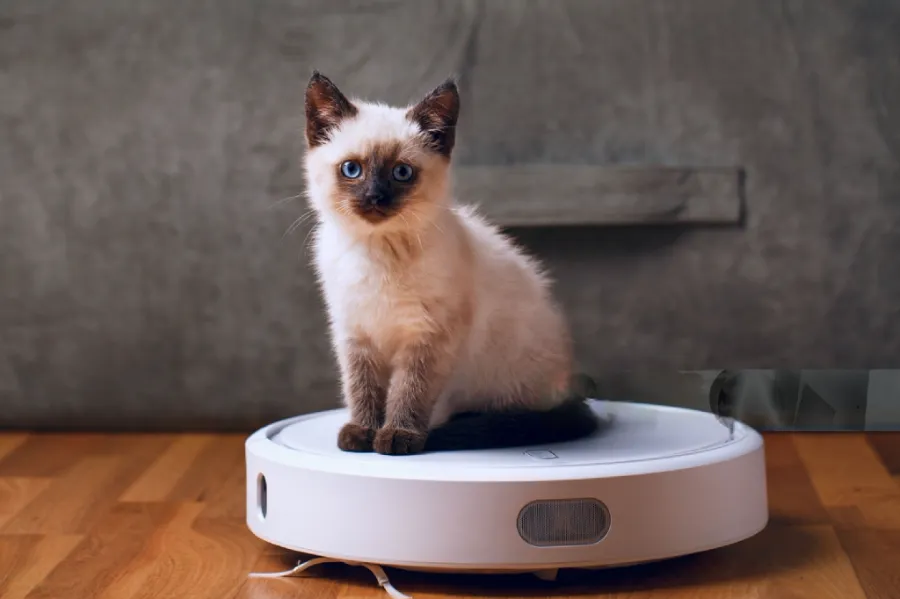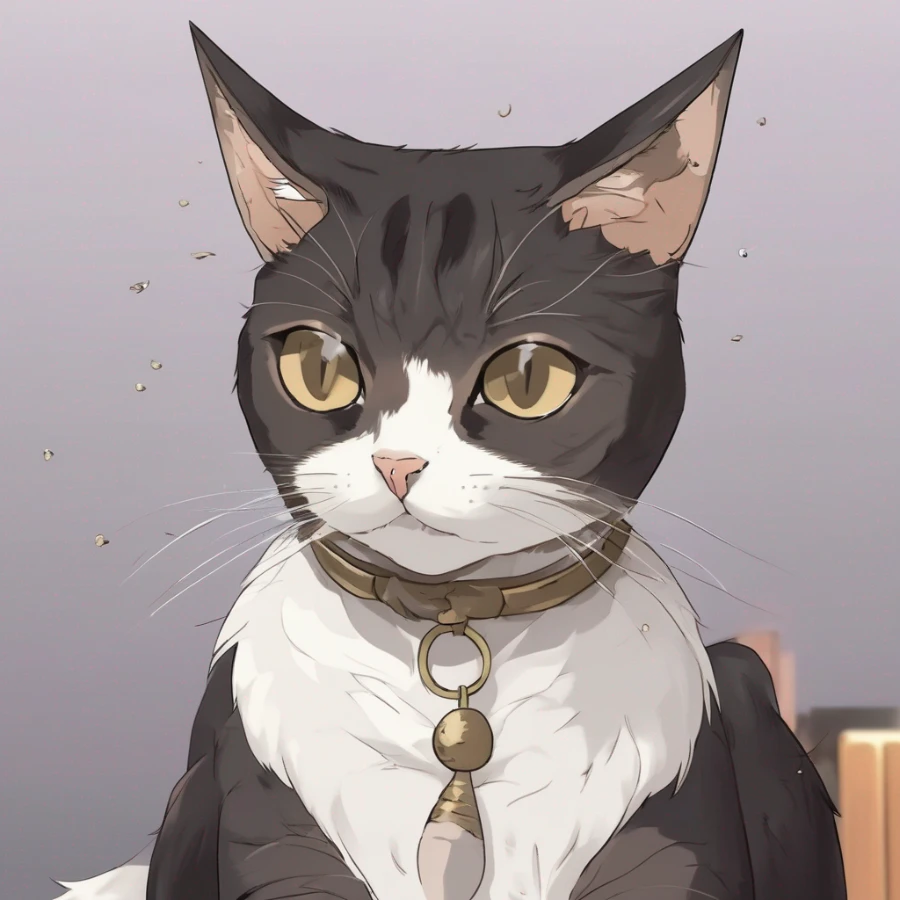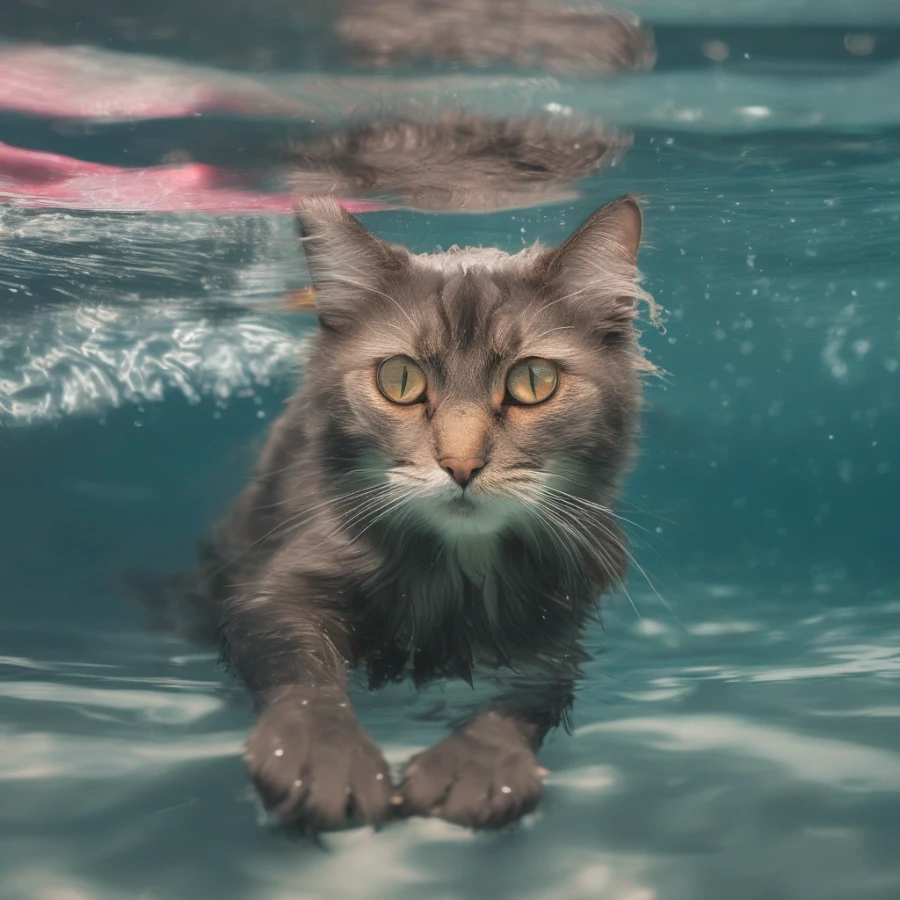Why Are Cats Scared of Vacuums

Published by: Tatsiana Korshik
Time to Read: 10 Min

Ever tried vacuuming around a cat only to witness the feline sprinting to the farthest corner like a professional sprinter escaping a starting gun? If you've had this experience, you're not alone. The enigma of why cats seem inherently terrified of vacuum cleaners is a puzzler for many pet owners. In this article, we're unraveling the mystery behind "Why Are Cats Scared of Vacuums" diving into the intriguing world of feline instincts, exploring historical contexts, and offering practical insights into decoding your cat's behavior. Whether you're a seasoned cat owner or a newbie in the world of feline companionship, understanding and addressing this fear can contribute to a harmonious home environment for both you and your whiskered friend. So, let's embark on this journey to demystify the vacuum-terror phenomenon and equip you with the tools to make vacuuming a less anxiety-inducing event for your feline companion.
Cats, as natural predators, possess heightened senses finely tuned to detect potential threats. This instinctual survival mechanism developed over thousands of years prompts an immediate response to unfamiliar or startling stimuli. When faced with the whirring noise and sudden movements of a vacuum cleaner, your cat's primal instincts kick in, triggering a flight response.
Cats' fear of vacuums isn't just a quirky behavior—it's hardwired. Their innate fear response kicks in, a survival instinct from their wild ancestors. In the wild, sudden loud noises signaled danger. For your cat, the vacuum's roar triggers a primal response, stirring the same fear that helped their ancestors avoid predators.
Their acute senses amplify this fear. Cats hear frequencies as high as 64 kHz, well beyond human capability. The vacuum's noise assaults their sensitive ears, making it akin to an impending threat. This heightened auditory sensitivity, coupled with their instinct to detect subtle movements, turns your harmless vacuum into a potential menace in their eyes.
Understanding this innate fear response is crucial. It isn't about being finicky; it's about survival instincts deeply ingrained in your cat's DNA. So, when your cat darts away from the vacuum, recognize it as a response to an ancient call for caution, not just a quirk of contemporary living.
Ever wondered why your cat seems to sense the vacuum long before you even plug it in? It's not magic—it's their extraordinary sensory toolkit at play. Cats have a superior sense of hearing, way beyond ours. While we max out at around 20,000 Hz, cats can hear frequencies up to 64,000 Hz. That hum your vacuum makes? It's practically a blaring siren to Fluffy.
But it's not just their ears. Cats' whiskers, those delicate-looking facial hairs, are precision instruments. They're embedded with nerves that detect even the slightest changes in air currents. When the vacuum starts, your cat's whiskers pick up on the disturbance in the force, alerting them to potential trouble.
And let's not forget their acute sense of smell. The vacuum doesn't just make noise; it stirs up scents too. Cats rely heavily on smell to navigate their world, and the sudden aroma upheaval caused by your vacuum can be overwhelming. So, next time Mr. Whiskers scurries away from your cleaning ritual, remember—it's not just the noise; it's a sensory overload, a symphony of stimuli that your cat's finely-tuned senses can't ignore.
Cats, your domestic furball, may seem light-years away from their wild ancestors, but deep down, the predator within still thrives. In the wild, survival meant staying alert to sudden movements—a twitch of a leaf or the rustle of prey. Fast forward to your living room, and that same instinct kicks in when the vacuum roars to life.
The predatory mindset is triggered by the vacuum's hum and movement. From a cat's perspective, the vacuum isn't just a cleaning tool; it's a potential threat. Cats instinctively view sudden, unpredictable motions as a signal to go into stealth mode. When your vacuum darts across the floor, your cat's inner hunter is on high alert.
This isn't a quirky reaction; it's evolution in action. Your cat's predatory mindset is hardwired from ancestors who relied on keen instincts for survival. So, when your cat pounces away from the vacuum, remember, it's not just fleeing a household appliance; it's channeling the wild instincts that have been etched into its DNA for generations.
Picture this: the wild landscape, rustling leaves, and the stealthy movement of potential prey. Now, transpose that scenario to your living room, and you'll understand why your cat treats the vacuum like an unwelcome intruder.
In the wild, noise meant danger—a twig snap or the crunch of leaves signaled an approaching predator. Fast forward to vacuum day, and your cat's ears pick up the same ominous tones. Your vacuum, innocuous to you, becomes a symphony of threats to your feline friend.
But it's not just the noise. The vacuum's unpredictable movements mimic the stealthy dance of prey or predator in the wild. Cats, finely tuned to detect motion, can't help but react. It's not merely an aversion to cleaning; it's a response hardwired by evolution. So, when your cat bolts at the whirr of the vacuum, it's not a mere quirk; it's an ancestral reflex, an instinctual dance to a primal beat.
Your home, a sanctuary for your cat, becomes a battleground when the vacuum emerges. The root? Territorial instincts deeply ingrained in your feline companion. Your cat meticulously marks its territory with scent glands, creating safe havens within your living space.
Now, introduce the vacuum. It's not just a cleaning device; it's an intrusion. The whirring disrupts familiar scents, challenging your cat's sense of security. Their instinctual response? Retreat to protect their territory.
This territorial tension isn't a simple aversion to noise; it's a fundamental clash between the perceived invader and the sacred spaces your cat calls its own. Understanding this primal struggle sheds light on why the vacuum transforms from a mundane appliance into a territorial threat, prompting your cat's swift escape to reclaim its sanctuary.
Your cat, a creature of habit, thrives on predictability. Yet, when the vacuum emerges, it transforms into an unpredictable monster in their eyes. Cats crave stability, a sense of knowing what to expect in their environment.
The vacuum disrupts this predictability. Its sudden movements and loud noises create an environment that's anything but routine for your cat. In their world, the vacuum becomes an unpredictable beast, a source of anxiety and fear.
It's not just about the vacuum doing its cleaning duty; it's about the perceived threat your cat faces. The unpredictability triggers their fight-or-flight response, with flight often being the chosen course. So, when your cat bolts at the sight of the vacuum, it's not mere skittishness; it's an instinctive reaction to an unpredictable monster invading their territory. Understanding this perception helps you navigate their anxiety and create a more feline-friendly cleaning routine.
Excessive grooming or, conversely, aggressive behavior can also emerge as stress responses. Pay attention to changes in vocalizations; increased meowing or hissing might signal discomfort. By keenly observing these behavioral cues, you become attuned to your cat's distress during vacuum sessions, allowing you to adjust your cleaning routine to ensure a more comfortable environment for your feline companion.
While your cat may not voice its concerns, stress often manifests physically. Keep a close eye on their coat—excessive shedding might indicate heightened anxiety. Changes in appetite, whether increased or decreased, can be subtle indicators of stress.
Digestive issues, such as vomiting or diarrhea, may also arise during stressful situations like vacuuming. Lethargy or, conversely, hyperactivity can be responses to heightened stress levels. By recognizing these physical manifestations, you gain valuable insights into your cat's well-being and can tailor your cleaning routine to minimize stress and ensure a healthier, happier pet.
Begin by acclimating your cat to the vacuum gradually. Start with short exposure periods while the vacuum is stationary. Reward positive behavior with treats or play, creating positive associations.
Establish safe zones where your cat can retreat during cleaning. Equip these areas with familiar scents, cozy bedding, and toys. This provides a refuge, minimizing the perceived threat of the vacuum.
Incorporate positive reinforcement during cleaning. Offer treats, playtime, or affection afterward. This conditions your cat to associate the vacuum with enjoyable experiences, mitigating anxiety over time.
Implementing these tips transforms vacuuming from a stress-inducing ordeal to a manageable, even positive, experience for your feline friend.
The Importance of Patience and Understanding
Patience is your ally. Recognize that overcoming vacuum anxiety is a gradual process. Be attuned to your cat's cues, understanding that each feline companion has its unique threshold for stress.
Building Trust
Above all, use this experience to strengthen your bond. Your understanding and compassion during vacuum sessions build trust. The more secure your cat feels, the less daunting the vacuum becomes, transforming what was once a conundrum into a shared challenge met with compassion and understanding.
Understanding Feline Fear: An Intro to the Vacuum Phobia
Ever wondered why your cat transforms into a stealthy ninja at the sight of a vacuum cleaner? In "Understanding the Fear Response in Cats," we unravel the mysteries of feline instincts. Tailored for business professionals sharing homes with these enigmatic creatures, this article decodes the sensory intricacies that make vacuums feline foes. Join us as we explore the intricate dance between cats and vacuums, demystifying the fear that lurks within your whiskered companion.Cats, as natural predators, possess heightened senses finely tuned to detect potential threats. This instinctual survival mechanism developed over thousands of years prompts an immediate response to unfamiliar or startling stimuli. When faced with the whirring noise and sudden movements of a vacuum cleaner, your cat's primal instincts kick in, triggering a flight response.
The Innate Fear Response
Cats' fear of vacuums isn't just a quirky behavior—it's hardwired. Their innate fear response kicks in, a survival instinct from their wild ancestors. In the wild, sudden loud noises signaled danger. For your cat, the vacuum's roar triggers a primal response, stirring the same fear that helped their ancestors avoid predators.
Their acute senses amplify this fear. Cats hear frequencies as high as 64 kHz, well beyond human capability. The vacuum's noise assaults their sensitive ears, making it akin to an impending threat. This heightened auditory sensitivity, coupled with their instinct to detect subtle movements, turns your harmless vacuum into a potential menace in their eyes.
Understanding this innate fear response is crucial. It isn't about being finicky; it's about survival instincts deeply ingrained in your cat's DNA. So, when your cat darts away from the vacuum, recognize it as a response to an ancient call for caution, not just a quirk of contemporary living.
Sensory Overload: Unraveling Cats' Heightened Senses
Ever wondered why your cat seems to sense the vacuum long before you even plug it in? It's not magic—it's their extraordinary sensory toolkit at play. Cats have a superior sense of hearing, way beyond ours. While we max out at around 20,000 Hz, cats can hear frequencies up to 64,000 Hz. That hum your vacuum makes? It's practically a blaring siren to Fluffy.
But it's not just their ears. Cats' whiskers, those delicate-looking facial hairs, are precision instruments. They're embedded with nerves that detect even the slightest changes in air currents. When the vacuum starts, your cat's whiskers pick up on the disturbance in the force, alerting them to potential trouble.
And let's not forget their acute sense of smell. The vacuum doesn't just make noise; it stirs up scents too. Cats rely heavily on smell to navigate their world, and the sudden aroma upheaval caused by your vacuum can be overwhelming. So, next time Mr. Whiskers scurries away from your cleaning ritual, remember—it's not just the noise; it's a sensory overload, a symphony of stimuli that your cat's finely-tuned senses can't ignore.
The Evolutionary Perspective: Cats and the Vacuum Threat
Ever wonder why your cat sees the vacuum as a mortal enemy? It's more than a modern oddity. In this section, we'll explore the evolutionary perspective behind cats' wariness of vacuums, tapping into the primal instincts that turn your cleaning device into a perceived threat. Get ready for a quick trip through the ancestral corridors of your cat's psyche.Ancestral Instincts: The Predatory Mindset
Cats, your domestic furball, may seem light-years away from their wild ancestors, but deep down, the predator within still thrives. In the wild, survival meant staying alert to sudden movements—a twitch of a leaf or the rustle of prey. Fast forward to your living room, and that same instinct kicks in when the vacuum roars to life.
The predatory mindset is triggered by the vacuum's hum and movement. From a cat's perspective, the vacuum isn't just a cleaning tool; it's a potential threat. Cats instinctively view sudden, unpredictable motions as a signal to go into stealth mode. When your vacuum darts across the floor, your cat's inner hunter is on high alert.
This isn't a quirky reaction; it's evolution in action. Your cat's predatory mindset is hardwired from ancestors who relied on keen instincts for survival. So, when your cat pounces away from the vacuum, remember, it's not just fleeing a household appliance; it's channeling the wild instincts that have been etched into its DNA for generations.
Noise and Motion: Triggers from the Wild
Picture this: the wild landscape, rustling leaves, and the stealthy movement of potential prey. Now, transpose that scenario to your living room, and you'll understand why your cat treats the vacuum like an unwelcome intruder.
In the wild, noise meant danger—a twig snap or the crunch of leaves signaled an approaching predator. Fast forward to vacuum day, and your cat's ears pick up the same ominous tones. Your vacuum, innocuous to you, becomes a symphony of threats to your feline friend.
But it's not just the noise. The vacuum's unpredictable movements mimic the stealthy dance of prey or predator in the wild. Cats, finely tuned to detect motion, can't help but react. It's not merely an aversion to cleaning; it's a response hardwired by evolution. So, when your cat bolts at the whirr of the vacuum, it's not a mere quirk; it's an ancestral reflex, an instinctual dance to a primal beat.
Modern Living: How Vacuums Clash with a Cat's Domestic Realm
Modern living meets feline mystery when vacuums disrupt our cats' peace. Discover the reasons behind your cat's vacuum fear and practical strategies to bridge the gap.Territorial Tensions: Disruption of Safe Spaces
Your home, a sanctuary for your cat, becomes a battleground when the vacuum emerges. The root? Territorial instincts deeply ingrained in your feline companion. Your cat meticulously marks its territory with scent glands, creating safe havens within your living space.
Now, introduce the vacuum. It's not just a cleaning device; it's an intrusion. The whirring disrupts familiar scents, challenging your cat's sense of security. Their instinctual response? Retreat to protect their territory.
This territorial tension isn't a simple aversion to noise; it's a fundamental clash between the perceived invader and the sacred spaces your cat calls its own. Understanding this primal struggle sheds light on why the vacuum transforms from a mundane appliance into a territorial threat, prompting your cat's swift escape to reclaim its sanctuary.
Unpredictable Monsters: Cats and the Perceived Threat
Your cat, a creature of habit, thrives on predictability. Yet, when the vacuum emerges, it transforms into an unpredictable monster in their eyes. Cats crave stability, a sense of knowing what to expect in their environment.
The vacuum disrupts this predictability. Its sudden movements and loud noises create an environment that's anything but routine for your cat. In their world, the vacuum becomes an unpredictable beast, a source of anxiety and fear.
It's not just about the vacuum doing its cleaning duty; it's about the perceived threat your cat faces. The unpredictability triggers their fight-or-flight response, with flight often being the chosen course. So, when your cat bolts at the sight of the vacuum, it's not mere skittishness; it's an instinctive reaction to an unpredictable monster invading their territory. Understanding this perception helps you navigate their anxiety and create a more feline-friendly cleaning routine.
Signs of Distress: Recognizing a Cat in Vacuum Distress
When the vacuum roars to life, your cat might exhibit subtle signs of distress. Watch for flattened ears—an instinctual attempt to shield against the perceived threat. Tail puffing or swishing may indicate agitation, while sudden hiding signals a desire for a secure escape.Excessive grooming or, conversely, aggressive behavior can also emerge as stress responses. Pay attention to changes in vocalizations; increased meowing or hissing might signal discomfort. By keenly observing these behavioral cues, you become attuned to your cat's distress during vacuum sessions, allowing you to adjust your cleaning routine to ensure a more comfortable environment for your feline companion.
Physical Symptoms: Stress Manifestations in Cats
While your cat may not voice its concerns, stress often manifests physically. Keep a close eye on their coat—excessive shedding might indicate heightened anxiety. Changes in appetite, whether increased or decreased, can be subtle indicators of stress.
Digestive issues, such as vomiting or diarrhea, may also arise during stressful situations like vacuuming. Lethargy or, conversely, hyperactivity can be responses to heightened stress levels. By recognizing these physical manifestations, you gain valuable insights into your cat's well-being and can tailor your cleaning routine to minimize stress and ensure a healthier, happier pet.
Managing the Vacuum Anxiety: Tips for a Stress-Free Cleaning
When it comes to keeping your cat calm during cleaning sessions, a few strategic moves can make all the difference.Gradual Desensitization: Introducing Cats to Vacuums
Begin by acclimating your cat to the vacuum gradually. Start with short exposure periods while the vacuum is stationary. Reward positive behavior with treats or play, creating positive associations.
Creating Safe Havens: Designing Cat-Friendly Spaces
Establish safe zones where your cat can retreat during cleaning. Equip these areas with familiar scents, cozy bedding, and toys. This provides a refuge, minimizing the perceived threat of the vacuum.
Positive Reinforcement: Associating Vacuums with Positive Experiences
Incorporate positive reinforcement during cleaning. Offer treats, playtime, or affection afterward. This conditions your cat to associate the vacuum with enjoyable experiences, mitigating anxiety over time.
Implementing these tips transforms vacuuming from a stress-inducing ordeal to a manageable, even positive, experience for your feline friend.
Conclusion: Navigating the Vacuum Conundrum with Compassion
In wrapping up the journey through the feline vacuum anxiety, two key elements stand tall—patience and understanding. It's not just about cleaning; it's about preserving the delicate balance between your cleaning routine and your cat's sense of security.The Importance of Patience and Understanding
Patience is your ally. Recognize that overcoming vacuum anxiety is a gradual process. Be attuned to your cat's cues, understanding that each feline companion has its unique threshold for stress.
Building Trust
Above all, use this experience to strengthen your bond. Your understanding and compassion during vacuum sessions build trust. The more secure your cat feels, the less daunting the vacuum becomes, transforming what was once a conundrum into a shared challenge met with compassion and understanding.



